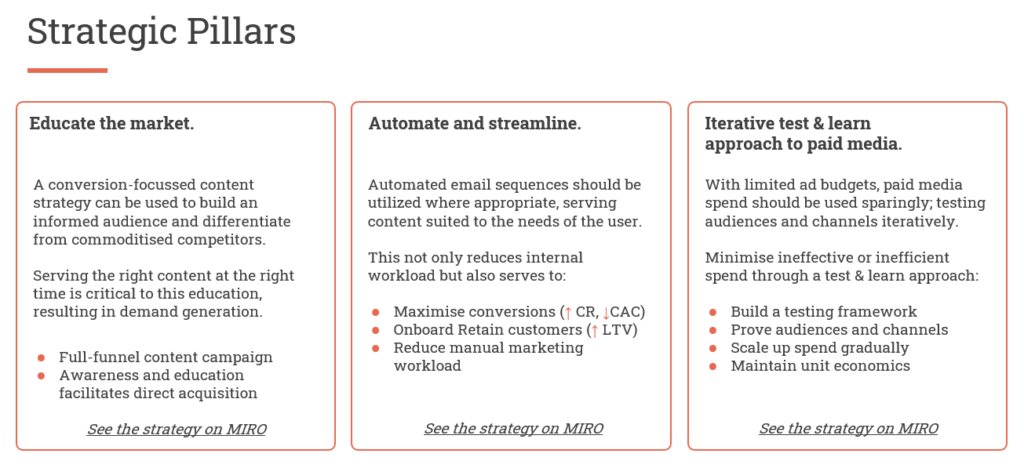
Your growth strategy deserves “Strategic Pillars”
Helping a startup founder build a growth strategy is something we do fairly regularly. Almost weekly. Inevitably, these strategies always look different from one business to the next.
This is because no two startups ever look the same. Different products, markets, funding, team shape/size, budgets, revenue model and so on. But one element of these growth plans is a consistent feature; the Strategic Pillar (I know that sounds like awful marketing jargon, but bear with me).
So what are Strategic Pillars? First, let’s start with ‘what’s a strategy?’.
It’s just a plan; get from one place to the next, with some specific actions and outcomes. Not very inspiring, is it? That’s why I love Strategic Pillars as a planning tool.
They might be called Strategic Initiatives, Key Focus Areas, Marketing Pillars, Priorities etc. They’re generally the same thing. Not to be confused with Objectives (more on that in another post).
Strategic Pillars is simply a concept or idea, explained in a couple of sentences. They add a layer of relatable narrative to business or marketing priorities, ironically to make the strategy sound less like marketing waffle. Generally speaking, these pillars should address specific opportunities, challenges or barriers to growth. If you’d like to see some real-world examples, please feel free to reach out.

Properly considered pillars should achieve a number of things;
Tell a Story
Adding a narrative helps to tell a story that generates internal buy-in through a better understanding of the workstream. Non-marketing functions within the business often have competing priorities for time, budget and resources. Generating cross-functional and vertical buy-in is really important when trying to get stuff done.
In the same way that storytelling has become commonplace in [content] marketing because it helps to connect the dots, the same techniques can be leveraged for better outcomes when building an internal strategy.
Shine a light on specific solutions
Strategic pillars help teams to focus in on solutions to identified problems, ensuring that we (the internal team) understand the challenges ahead and have a plan to address them.
Adding a narrative to a solution means it’s not lost or forgotten or deprioritised as BAU ramps up; it keeps the workflow, and ultimately the end goal, front of mind.
Simplify
There’s a reason why we often strive for simplicity, in marketing as in business. Simplification results in better outcomes.
When one articulates a complex workstream in a simple, digestible soundbite one also offers clarity of vision. A well-written strategic initiative should convey the What and the Why, in simple terms, with a little bit of the How sprinkled on top.
Offer Context
It’s difficult to overstate the importance of context in marketing. Context can makes a mediocre ad excellent, and vice versa. Context can help you win awards or get you into hot water.

Within the context of building a strategy, it helps to categorise sub-strategies and workstreams that might otherwise lack crucial context.
Contextualisation frames a problem/solution with relative importance (priority), relative complexity (difficulty) and the potential effect (impact).
With a clear understanding of the priority, difficulty and potential impact of a project a team is far more likely to implement a strategic initiative effectively.
It doesn’t matter what you call them, but adding a layer of narrative on top of your marketing priorities is a reliable way to increase the likelihood of delivering a strategy effectively. Give it a try.
